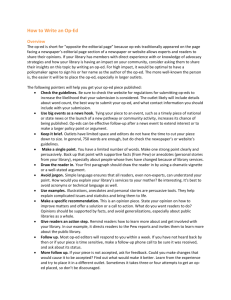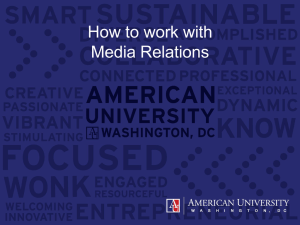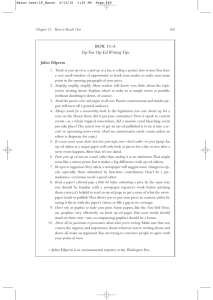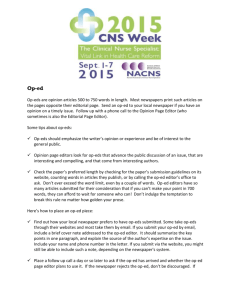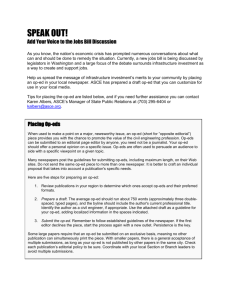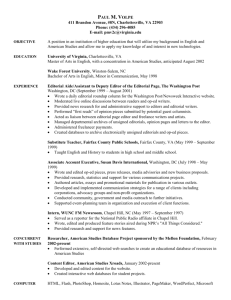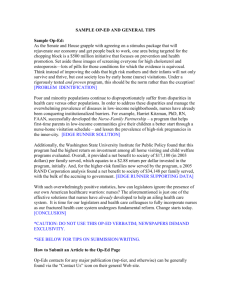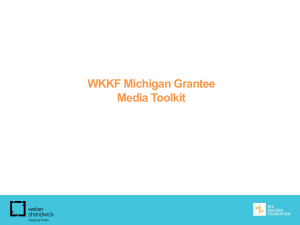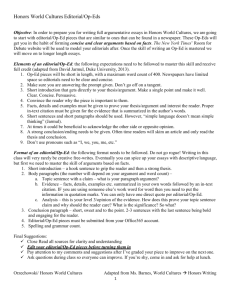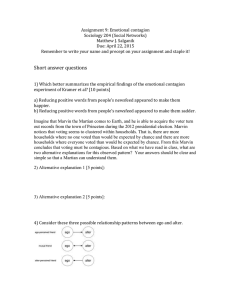What makes a good piece?
advertisement
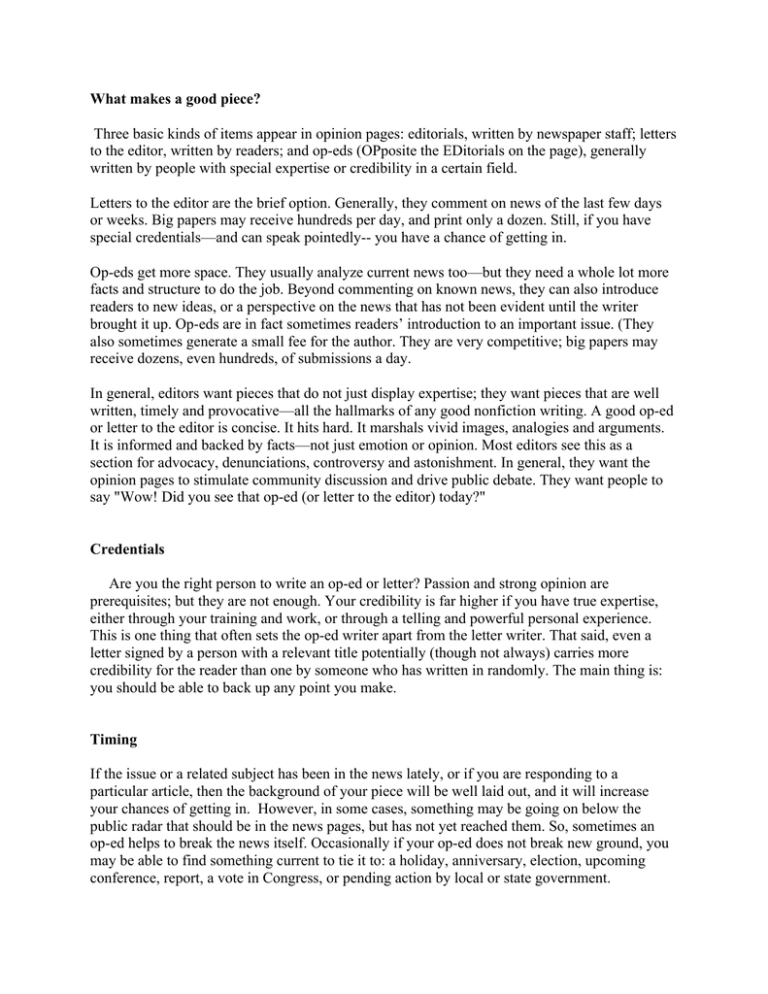
What makes a good piece? Three basic kinds of items appear in opinion pages: editorials, written by newspaper staff; letters to the editor, written by readers; and op-eds (OPposite the EDitorials on the page), generally written by people with special expertise or credibility in a certain field. Letters to the editor are the brief option. Generally, they comment on news of the last few days or weeks. Big papers may receive hundreds per day, and print only a dozen. Still, if you have special credentials—and can speak pointedly-- you have a chance of getting in. Op-eds get more space. They usually analyze current news too—but they need a whole lot more facts and structure to do the job. Beyond commenting on known news, they can also introduce readers to new ideas, or a perspective on the news that has not been evident until the writer brought it up. Op-eds are in fact sometimes readers’ introduction to an important issue. (They also sometimes generate a small fee for the author. They are very competitive; big papers may receive dozens, even hundreds, of submissions a day. In general, editors want pieces that do not just display expertise; they want pieces that are well written, timely and provocative—all the hallmarks of any good nonfiction writing. A good op-ed or letter to the editor is concise. It hits hard. It marshals vivid images, analogies and arguments. It is informed and backed by facts—not just emotion or opinion. Most editors see this as a section for advocacy, denunciations, controversy and astonishment. In general, they want the opinion pages to stimulate community discussion and drive public debate. They want people to say "Wow! Did you see that op-ed (or letter to the editor) today?" Credentials Are you the right person to write an op-ed or letter? Passion and strong opinion are prerequisites; but they are not enough. Your credibility is far higher if you have true expertise, either through your training and work, or through a telling and powerful personal experience. This is one thing that often sets the op-ed writer apart from the letter writer. That said, even a letter signed by a person with a relevant title potentially (though not always) carries more credibility for the reader than one by someone who has written in randomly. The main thing is: you should be able to back up any point you make. Timing If the issue or a related subject has been in the news lately, or if you are responding to a particular article, then the background of your piece will be well laid out, and it will increase your chances of getting in. However, in some cases, something may be going on below the public radar that should be in the news pages, but has not yet reached them. So, sometimes an op-ed helps to break the news itself. Occasionally if your op-ed does not break new ground, you may be able to find something current to tie it to: a holiday, anniversary, election, upcoming conference, report, a vote in Congress, or pending action by local or state government. Which Publication? Consider your readers before you do anything. Are you submitting to a national, generalinterest publication? If not, narrow your scope to something that pertains to the readership of that publication. Do not write about oil rights in Alaska if you are sending your op-ed to Tennessee— unless you are addressing oil prices across the country. Editors of local and regional papers also look for community interest or a strong local angle., and unless there is considerable public debate already, will be less receptive to op-eds about national issues or broad ideas. In this case, you can try telling a local story, usually about a real person, family or group and how your issue affects them. Writing the piece An op-ed is generally 500-750 words. It must unfold quickly. Focus on one issue or idea, briefly express your opinion in your opening paragraph, and be clear and confirmed in your viewpoint. The following paragraphs should back your viewpoint with factual, researched, or first-hand information. A good op-ed is not just an opinion; it consists of fact put into wellinformed context. Be timely and controversial--but not outrageous. Personal, conversational, and humorous (when appropriate) writing is important to readability, and to capturing the reader’s attention. Make sure that you educate without preaching. Near the end, clearly restate your position and issue a call to action. If you are discussing a problem, then offer a solution or a better approach; this takes the reader beyond mere criticism. Try to include a catchy title for your op-ed that emphasizes your central message. This will help the editor grasp the idea quickly, and help sell the piece. (However, be prepared for the paper to write its own headline; they will rarely use the writer’s head no matter how good it is. That’s just the way it’s done.) Here are some specific devices to keep in mind as you write. • • • • • • • • • Come down hard on one side of the argument, and never equivocate. Identify the counterargument, and refute it with facts. Emphasize active verbs; go easy on adjectives and adverbs. Avoid clichés. Avoid technical jargon and acronyms Try to grab the reader's attention in the first line. End with a strong or thought-provoking line. Use specific references and easy-to-understand data rather than abstraction. Anecdotes can sometimes help enhance understanding of an issue. Ideally, your topic will be timely, but at the same time have a long shelf life (i.e., the problem won’t be solved in a month).

